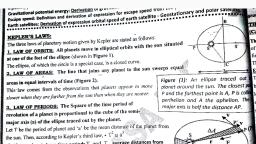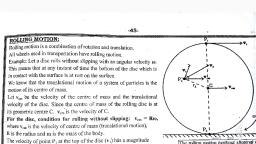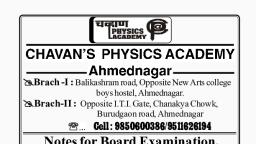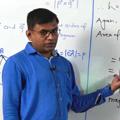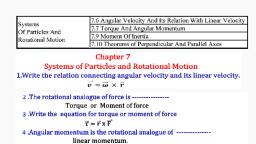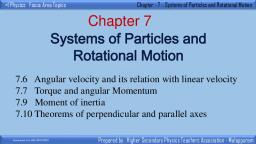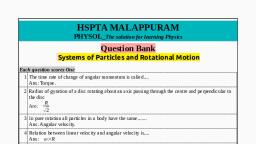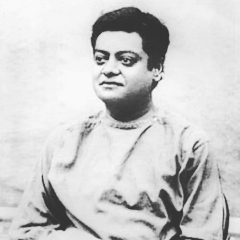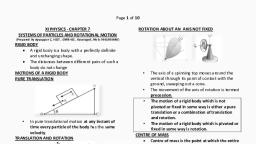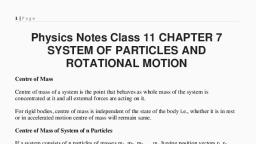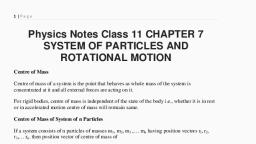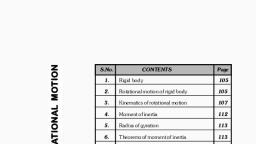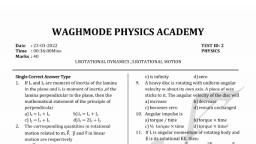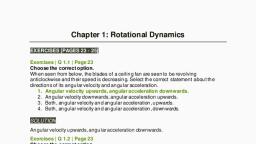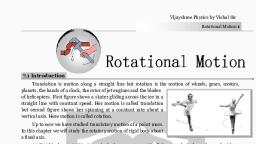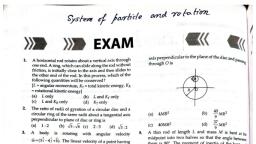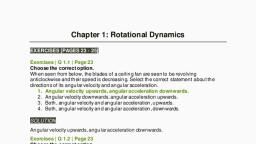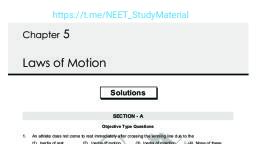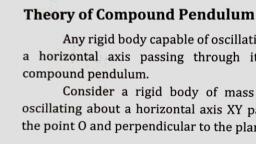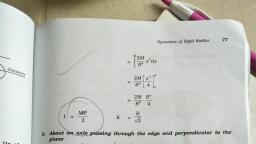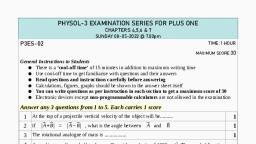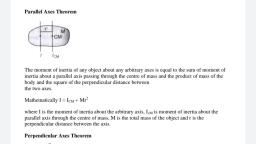Page 1 :
a) Perpendicular axis theorem :, Statement = the moment of inertia of a planar body (lamina ) about an axis perpendicular, to its plane is equal to the sum of its moment of inertia about two perpendicualr axis, concurrent with perpendicular axis and lying in the plane of the body ”., , e, , %, , The above figure shows a planar body. An axis perpendicular to the body through a point, ‘O’ istaken as z-axis .Two mutually perpendicular axis lying in the plane of the body and, , concurrent with z - axis i.e passing through ‘O’ are takenas x & ) axis., , The theorem states that /, =/,+J/,, , (EThearsen KOM EB Atal avic >.
Page 2 :
(b) Theorem of parallel axis :, Statement :- “ The moment of inertia of a body about an axis is equal to the sum of the, moment of inertia of the body about a parallel axis passing through its centre of mass and, the product of its mass and the square of the distance between the two parallel axis”, , Z & Z' are two parallel axis separated by a distance ‘a’ The Z - axis passes through the, , centre of mass ‘O” of the rigid body. Then according to the theorem of parallel axis ;, , [=L+Mr?, , When J. & J ! are the moments of inertia of the body about the Z & Z' axis respectively., ‘M’ isthe total mass of the body and ‘a’ is the perpendicular distance between two, parallel axis.
Page 3 :
ie |, , , , i ment of inertia Of a diy, rallel axis theorem , obtain the expression for mo, 7, Using paratle' A ), , | i ar AXIS pa:, ott ean ‘or moment of inertia about a perpendicu sp ssig, Assume the exp f, , though its centre., , f nd through its centre,, Moment of inertia o, , the disc about an axis perpendicular to it a!, , oR, , , , , , , , J, , Where ‘M? is the mass of the disc and ‘R’ is the radius. The disc can be considered tobe, , a planar body. Hence the theorem of perpendicular axis is applicable to it. Consider tie, , concurrent axis through the center of the disc, , 1,=1, 41,, , Here; x & y axisare along two diameters of the di, ’ disc is same about any diameter,, , , , 0aS x,y & Z axis., , sc and by symmentry the M.lofthe, , Hence; J, =I,, & I,=21,, MR?, , |, , |, , |, , 8. Using perpendicular axis th ; ott |, S perp: eorem , obtain the expression for M.I of a ring 4°, , => its diameter. E °
Page 4 :
SAS, , assume mee fo ie about a perpendicular axis passing through the centre., Moment of inertia ofa circular ring about an axis perpendicular to it and through its centre, , is;, , I = MR”, , grate the mass of the disc & ‘R’ is its radius. The ring can be considered to be a planar, body Hence ; the theorem of perpendicular axis is applicable to it., , , , consider three concurrent axis through the centre ‘O’ of the ring as ; x. Vv & Zz axis, , x&y axis lie in the plane of the disc & 2. is perpendicular to it., , By the theorem of perpendicular axis ;, , Lelyhd, ., , Here; x & y axis are along two diameters of the ring and by symmentry , the M.l of the, ting is the same about any diameter., , Hence ;, , 1=I,, . =2I,, , eee set, , ees
Page 5 :
UISLALIVG VCLWOCLL UIE LWYU PdaldliUl GAGS. ~, , KINEMATICS OF ROTATIONAL MOTION ABOUT A FIXED AXIS: | |, , The kinematical quantities in rotational motion, angular displacement (8), ., angular velocity (@) and angular accelerati ivel ond = The theorem of parallel axes, 2) eleration (a) respectively corresp axes are tu0 parallel axes se, i a distance a: O is the centre, , to kinematic quantities in linear motion, displacement (x), velocity (v) and, the body, OO" = &, , acceleration (a):, We know the kinematical equations of linear motion with uniform (i.e. constagt) acceleration:, , (2) x=x +Vot + zat (3) v? = vo + 2a( xX- Xo)., , (1) v=vo+at, = initial velocity., , , , Where Xo = initial displacement and vo, The word ‘initial’ refers to values of the quantities at t= 0, The corresponding kinematic equations for rotational motion with, , @) Oo” = = «8 “7 a(0- 8), , saa Oo = initial angular velocity of the body., , uniform angular acceleration are, , , , , , 1, (2) 0=0y toot +5 at”, , , , (1) o=@)+at, , Where 0) = initial angular displacement of the rotating bod, war nAarD 4 DANUEDP IN TERMS OF TORQUE 2” rie
